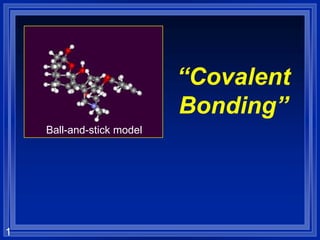
Chapter 8 covalent bonding
- 2. 2 Objectives –Explain the role and location of electrons in a covalent bond. –Describe the change in energy and stability that takes place as a covalent bond forms. –Compare covalent and ionic compounds.
- 3. 3 Bonds are… Forces that hold groups of atoms together and make them function as a unit. Two types: 1) Ionic bonds – transfer of electrons (gained or lost; makes formula unit) 2) Covalent bonds – sharing of electrons. The resulting particle is called a “molecule”
- 4. 4 Molecules The simplest example of sharing electrons is found in diatomic molecules. For example, air contains oxygen molecules, consisting of two oxygen atoms joined covalently (O2) Air also contains hydrogen molecules, consisting of two hydrogen atoms join covalently (H2)
- 5. 5 How does H2 form? Both nucleus repel each other, since they both have a positive charge (like charges repel). ++ (diatomic hydrogen molecule) + +
- 6. 6 How does H2 form? ++ But, the nuclei are attracted to the electrons They share the electrons, and this is called a “covalent bond”, and involves only NONMETALS!
- 7. 7 Covalent bonds Nonmetals hold on to their valence electrons. They can’t give away electrons to bond. –But still want noble gas configuration. Nonmetals get it by sharing valence electrons with each other = covalent bonding By sharing, both atoms get to count the electrons toward a noble gas configuration.
- 8. 8 Energy and Stability Most individual atoms have low stability. – Remember, if an atom doesn’t have eight valence electrons they are unstable. They become more stable when they are part of a compound. Individual atoms also have higher potential (stored) energy. When atoms are bonded they are at their lowest potential energy. The distance between two bonded atoms at their lowest potential energy is the bond length
- 10. 10 Covalent bonding Fluorine has seven valence electrons (but would like to have 8) F
- 11. 11 Covalent bonding Fluorine has seven valence electrons A second atom also has seven F F
- 12. 12 Covalent bonding Fluorine has seven valence electrons A second atom also has seven By sharing electrons… F F
- 13. 13 Covalent bonding Fluorine has seven valence electrons A second atom also has seven By sharing electrons… F F
- 14. 14 Covalent bonding Fluorine has seven valence electrons A second atom also has seven By sharing electrons… F F
- 15. 15 Covalent bonding Fluorine has seven valence electrons A second atom also has seven By sharing electrons… F F
- 16. 16 Covalent bonding Fluorine has seven valence electrons A second atom also has seven By sharing electrons… F F
- 17. 17 Covalent bonding Fluorine has seven valence electrons A second atom also has seven By sharing electrons… …both end with full orbitals F F
- 18. 18 Covalent bonding Fluorine has seven valence electrons A second atom also has seven By sharing electrons… …both end with full orbitals F F 8 Valence electrons
- 19. 19 Covalent bonding Fluorine has seven valence electrons A second atom also has seven By sharing electrons… …both end with full orbitals F F 8 Valence electrons
- 20. 20 A Single Covalent Bond is... A sharing of two valence electrons. Only nonmetals and hydrogen form covalent bonds. Different from an ionic bond because they actually form molecules. H - H
- 21. 21 Multiple Bonds Sometimes atoms share more than one pair of valence electrons. A double bond is when atoms share two pairs of electrons O = O A triple bond is when atoms share three pairs of electrons (6 total) N N What’s the deal with the oxygen dot diagram?
- 22. 22 Bond Strength The shorter the bond the stronger the bond –Triple bond > double bond > single bond
- 23. 23 Types of Covalent Bonds A covalent bond in which the bonding electrons in the molecular orbital are shared equally is a nonpolar covalent bond. A covalent bond in which the bonding electrons in the molecular orbital are shared unequally is a polar covalent bond.
- 24. 24
- 25. 25 Ionic Compounds vs. Covalent Compounds Ionic compounds The Union of a metal and nonmetal Transferred Electrostatic Strong Solid High Good Subject Definition How are the electrons arranged Forces that hold the bond together Strength of Bonds (weak or strong) State of matter @ room temperture Melting Point & Boiling Point Conduction Covalent compounds The union of two or more nonmetals/metalloid Shared Electrostatic Weak Gas or Liquid Low Poor